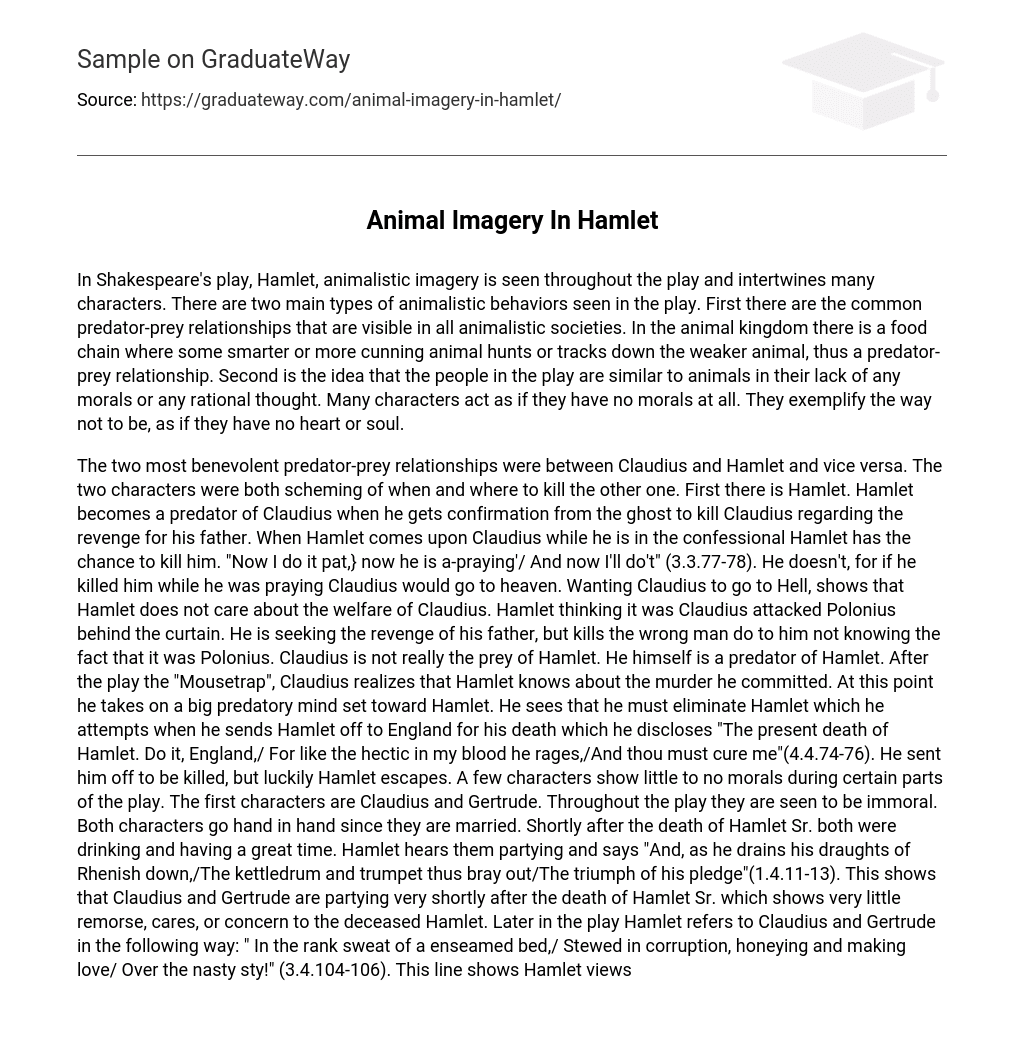In Shakespeare’s play, Hamlet, animalistic imagery is seen throughout the play and intertwines many characters. There are two main types of animalistic behaviors seen in the play. First there are the common predator-prey relationships that are visible in all animalistic societies. In the animal kingdom there is a food chain where some smarter or more cunning animal hunts or tracks down the weaker animal, thus a predator-prey relationship. Second is the idea that the people in the play are similar to animals in their lack of any morals or any rational thought. Many characters act as if they have no morals at all. They exemplify the way not to be, as if they have no heart or soul.
The two most benevolent predator-prey relationships were between Claudius and Hamlet and vice versa. The two characters were both scheming of when and where to kill the other one. First there is Hamlet. Hamlet becomes a predator of Claudius when he gets confirmation from the ghost to kill Claudius regarding the revenge for his father. When Hamlet comes upon Claudius while he is in the confessional Hamlet has the chance to kill him. “Now I do it pat,} now he is a-praying’/ And now I’ll do’t” (3.3.77-78).
He doesn’t, for if he killed him while he was praying Claudius would go to heaven. Wanting Claudius to go to Hell, shows that Hamlet does not care about the welfare of Claudius. Hamlet thinking it was Claudius attacked Polonius behind the curtain. He is seeking the revenge of his father, but kills the wrong man do to him not knowing the fact that it was Polonius. Claudius is not really the prey of Hamlet. He himself is a predator of Hamlet. After the play the “Mousetrap”, Claudius realizes that Hamlet knows about the murder he committed. At this point he takes on a big predatory mind set toward Hamlet. He sees that he must eliminate Hamlet which he attempts when he sends Hamlet off to England for his death which he discloses “The present death of Hamlet.
Do it, England,/ For like the hectic in my blood he rages,/And thou must cure me”(4.4.74-76). He sent him off to be killed, but luckily Hamlet escapes. A few characters show little to no morals during certain parts of the play. The first characters are Claudius and Gertrude. Throughout the play they are seen to be immoral. Both characters go hand in hand since they are married. Shortly after the death of Hamlet Sr. both were drinking and having a great time. Hamlet hears them partying and says “And, as he drains his draughts of Rhenish down,/The kettledrum and trumpet thus bray out/The triumph of his pledge”(1.4.11-13).
This shows that Claudius and Gertrude are partying very shortly after the death of Hamlet Sr. which shows very little remorse, cares, or concern to the deceased Hamlet. Later in the play Hamlet refers to Claudius and Gertrude in the following way: ” In the rank sweat of a enseamed bed,/ Stewed in corruption, honeying and making love/ Over the nasty sty!” (3.4.104-106). This line shows Hamlet views his mom and Claudius as animals for animals live in a sty. They make love in there sty like animals. Another aspect of this quote needs to be looked at is that they are making love.
Claudius, the deceased Hamlet Senior’s brother, is having sex with the dead Hamlet’s wife. This is immoral they do not have regard or feelings toward Hamlet Jr. at all, for if they did they would not have relations with one another visible to where he knows about it. Their immoral behavior and shows they are like many animals in that animals have no regard or any visible regard toward other animals. Laertes is a character that has very little morals and seems to have no rational thought until the very end of the play.
He comes back from France, to find his father had been murdered. He being very angered goes on a rampage seeking the death of Hamlet. While he does this, he cares nothing about his afterlife at all. He says “To cut his throat I’ th’ church”(4.7.144). By this he is saying that he would kill Hamlet in a church. To kill someone in a church is very animalistic, for it shows no care or morals such as an animal. Laertes even likens himself to an animal when he says “like the kind life rend’ring pelican” (4.5.168).
An animal does not care where it kills its prey. Rosencrantz and Guildenstern are also characters seen as animals. These characters are animals because they are immoral. They are immoral for they act as Hamlet’s friend, but that they turn around and spy on him. They are working for the king, the person that Hamlet hates the most, and are spying on Hamlet. Only an animal would have such a not caring attitude toward one of its own kind. Hamlet talking about trusting Rosecrantz and Guildenstern says “and my two school fellows,/ Whom I will trust as I will adders fanged” (3.4.225-226). He says he would trust them as if they were snakes, which cannot be trusted for they care not about the person they are with, only about themselves.
Shakespeare does a good job of bringing many characters into the play with an animal parallel. This shows that Shakespeare wanted these people to be seen as animals which are immoral, not trustworthy, and blood hungry. In the end all of the characters likened to animals die or are killed and the ones that aren’t remain for the most part. The animal imagery in Hamlet is a key theme throughout the play.





